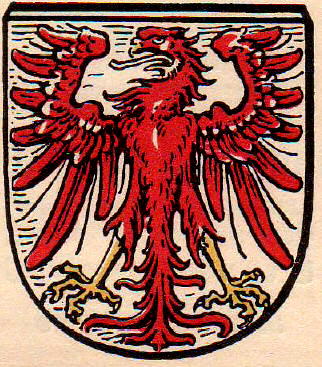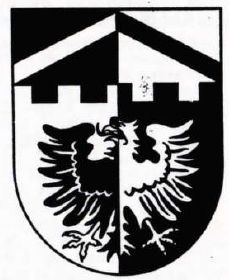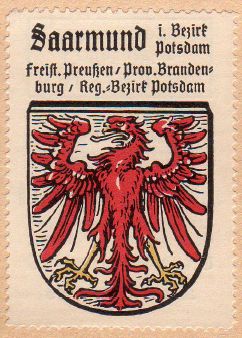Saarmund: Difference between revisions
Knorrepoes (talk | contribs) m (Text replacement - "===Official blazon=== " to "{| class="wikitable" |+Official blazon |- |'''German''' | ") Tags: Mobile edit Mobile web edit |
Knorrepoes (talk | contribs) m (Text replacement - " :[[" to " : [[") Tags: Mobile edit Mobile web edit |
||
| (13 intermediate revisions by the same user not shown) | |||
| Line 1: | Line 1: | ||
'''SAARMUND''' | '''SAARMUND''' | ||
State : [[Brandenburg]]<br/> | State : [[Brandenburg]]<br/> | ||
District (Kreis) : [[Potsdam-Mittelmark]]<br> | District (Kreis) : [[Potsdam-Mittelmark]]<br> | ||
Incorporated into : 2003 [[Nuthetal]] | Incorporated into :2003 [[Nuthetal]] | ||
[[File:saarmund.jpg|center|Wappen von {{PAGENAME}}]] | [[File:saarmund.jpg|center|alt=Wappen von {{PAGENAME}}/Arms (crest) of {{PAGENAME}}]] | ||
{| class="wikitable" | {| class="wikitable" | ||
| Line 13: | Line 11: | ||
|- | |- | ||
|'''German''' | |'''German''' | ||
| | | blazon wanted | ||
|- | |||
|'''English''' | |||
| blazon wanted | |||
|} | |||
===Origin/meaning=== | ===Origin/meaning=== | ||
| Line 21: | Line 23: | ||
In 1994 H. Heese also made a proposal, shown below. It showed the eagle and in chief the Saar and Nuthe rivers and a division line which refers to a former powerful castle in the area. This porposal was never approved. | In 1994 H. Heese also made a proposal, shown below. It showed the eagle and in chief the Saar and Nuthe rivers and a division line which refers to a former powerful castle in the area. This porposal was never approved. | ||
[[File:saarmund1.jpg|center|Wappen von {{PAGENAME}}]] | [[File:saarmund1.jpg|center|alt=Wappen von {{PAGENAME}}/Arms (crest) of {{PAGENAME}}]] | ||
{|align="center" | {|align="center" | ||
|align="center"|[[File:saarmund.hagd.jpg|center|Wappen von {{PAGENAME}}]] <br/>The arms by [[Otto Hupp|Hupp]] in the [[Kaffee Hag albums]] +/- 1925 | |align="center"|[[File:saarmund.hagd.jpg|center|Wappen von {{PAGENAME}}/Coat of arms (crest) of {{PAGENAME}}]] <br/>The arms by [[Otto Hupp|Hupp]] in the [[Kaffee Hag albums]] +/- 1925 | ||
|} | |} | ||
{{de}} | |||
{{media}} | {{media}} | ||
[[Civic Heraldry Literature - Germany|Literature]] : Hupp, O: [[Kaffee Hag albums]], 1920s; Heese, 1994 | [[Civic Heraldry Literature - Germany|'''Literature''']]:Hupp, O:[[Kaffee Hag albums]], 1920s; Heese, 1994 | ||
[[Category:German Municipalities S]] | [[Category:German Municipalities S]] | ||
[[Category:Brandenburg]] | [[Category:Brandenburg]] | ||
[[Category:Potsdam-Mittelmark]] | [[Category:Potsdam-Mittelmark]] | ||
Latest revision as of 06:29, 13 August 2024
SAARMUND
State : Brandenburg
District (Kreis) : Potsdam-Mittelmark
Incorporated into :2003 Nuthetal
| German | blazon wanted |
| English | blazon wanted |
Origin/meaning
The arms show the eagle of Brandenburg, taken from the only known historical seal of the city, dating from 1788. Saarmund returned the city rights in 1862 (to avoid a war tax), which meant that the eagle could no longer be used, as only cities had the right to bear arms at the time. Seals after 1862 thus only showed the name of the village. It is thus not known whether the city actually used the eagle as arms, or only in the seals. Hupp designed the arms in the 1910s based on the seal.
In 1992 the council wanted to adopt arms due to the 775th anniversary of the town. Six proposals were made, all with (parts) of the eagle, but none was finally approved by the council. The municipality thus never had official arms.
In 1994 H. Heese also made a proposal, shown below. It showed the eagle and in chief the Saar and Nuthe rivers and a division line which refers to a former powerful castle in the area. This porposal was never approved.
| The arms by Hupp in the Kaffee Hag albums +/- 1925 |
This page is part of the German heraldry portal Deutsche Wappensammlung |
Heraldry of the World |
|
German heraldry:
|
Selected collector's items from Germany:
|
Contact and Support
Partners:
Your logo here ?
Contact us
© since 1995, Heraldry of the World, Ralf Hartemink 
Index of the site
Literature:Hupp, O:Kaffee Hag albums, 1920s; Heese, 1994














